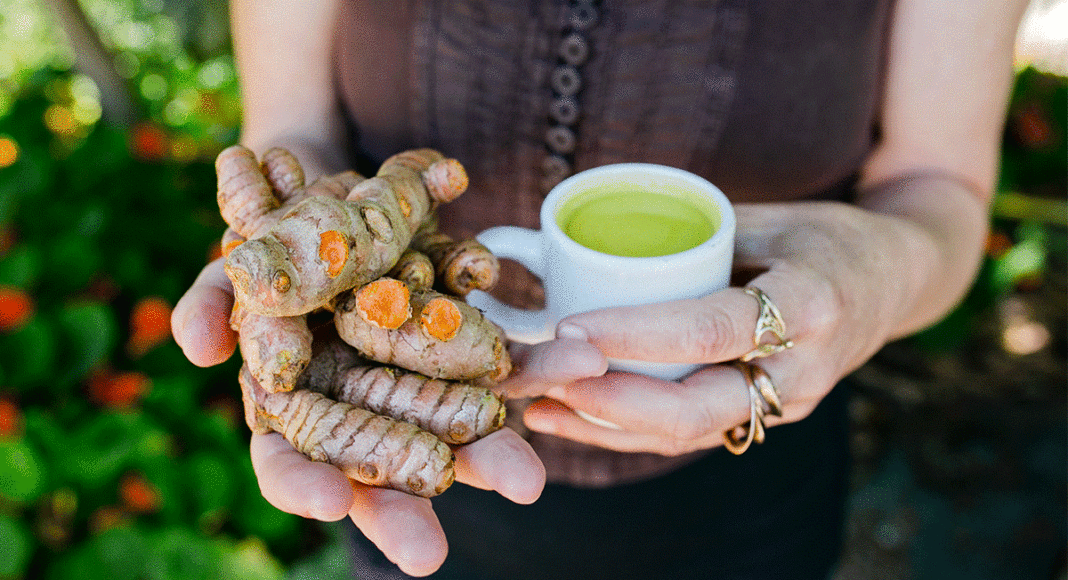Turmeric, a tropical-plant cousin of ginger, has roots that are so deeply orange they make tanning bed enthusiasts twinge with pangs of jealousy, and they have left yellow stains on many a cutting board. Native to southern Asia, turmeric’s richly hued roots may bring a wealth of health benefits to those who consume it.
“Turmeric is good for people with inflammation,” says Talya Lutzker, a local certified Ayurvedic practitioner for more than 16 years. “Most holistic practitioners believe inflammation is at the root of most diseases.” This includes cancer, arthritis, autoimmune disorders, heart disease, and digestive issues, among others. Many studies have confirmed turmeric’s ability to mitigate inflammation in the body, including a 2009 review published in The International Journal of Biochemistry and Cell Biology that provided evidence that circumin, turmeric’s main bioactive ingredient, may play a role in both the prevention and treatment of inflammatory chronic diseases.
But turmeric’s health-supporting qualities may also extend beyond the body to the mind. A 2013 study published in the journal Behavioural Brain Research showed that curcumin can increase levels of the brain hormone BDNF—low levels of which have been linked to many diseases of the brain, like depression and Alzheimer’s disease. “Turmeric is good at cleaning the blood and opening circulatory pathways,” says Lutzker, who compares the blood and lymph systems to the two rivers of the body. “There is no way that doesn’t reach the brain.”
Turmeric comes in two forms, which Lutzker notes have different properties. Traditionally, turmeric has been thought of as a spice, when its roots are ground and dried. This is also the form available in supplements, which Lutzker advises should be combined with black pepper in order to significantly enhance absorption. She adds that the dried form is most appropriate for people whose constitution is wet, oily, and congested, and for those with high blood pressure or high cholesterol.
The fresh form, which can be purchased at Asian markets and health food stores, is better for people who tend to have drier and hotter constitutions, says Lutzker, who emphasizes the Ayurvedic principle of taking an individual-based approach. “When you use foods and herbs medicinally to shift an issue, feel better, or heal, you should feel their effects,” she says.
Regardless of whether you choose the dried or fresh, the functionally relevant question is how to regularly incorporate turmeric into the diet. For the dried and ground form, Lutzker, who is also the author of the cookbook The Ayurvedic Vegan Kitchen, recommends making a simple spice mix that highlights turmeric’s healing ability. She suggests mixing one-fourth cup ground turmeric with one tablespoon each of black pepper, cinnamon and cardamom, and two tablespoons each of ground coriander and dried rosemary. This mix can then be easily added to a variety of foods like mashed potatoes, salad dressings, vegetables, and even to-go and take-out foods in order to increase their healthfulness. “Always put turmeric with two to three other ‘spice friends’ to aid in assimilating it deep into the tissues,” says Lutzker. “I also really love to put turmeric on eggs. It is a digestively supportive spice for protein digestion,” she says, adding that the spice mix makes a great rub for meat dishes. Another trendy way to eat more turmeric is in “golden milk,” which is simply any type of milk—animal or plant-based—warmed to infuse it with turmeric and other spices. It’s easy to make at home, but is also beginning to appear in stores.
To get more fresh turmeric into the diet, Lutzker says you can use it exactly like garlic or ginger. “One of my favorite things to do with turmeric is to grate it,” she says, recommending two tablespoons on top of soups. “You can also chop it into discs and infuse any pot of grain, like rice,” she adds.
But no matter which form of turmeric is consumed, Lutzker emphasizes the importance of breathing and mindful eating, too. “The most powerful anti-inflammatory we have is oxygen,” she says. “If someone really wants to get the most out of their turmeric, take five deep breaths before taking the first bite. It makes a world of difference to get present before you eat.”













